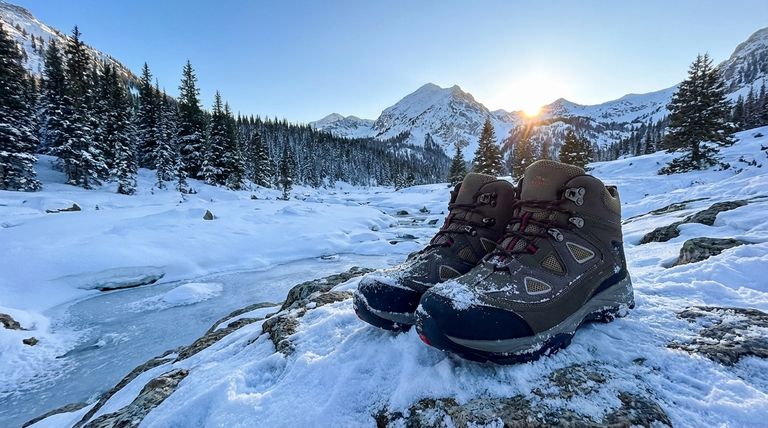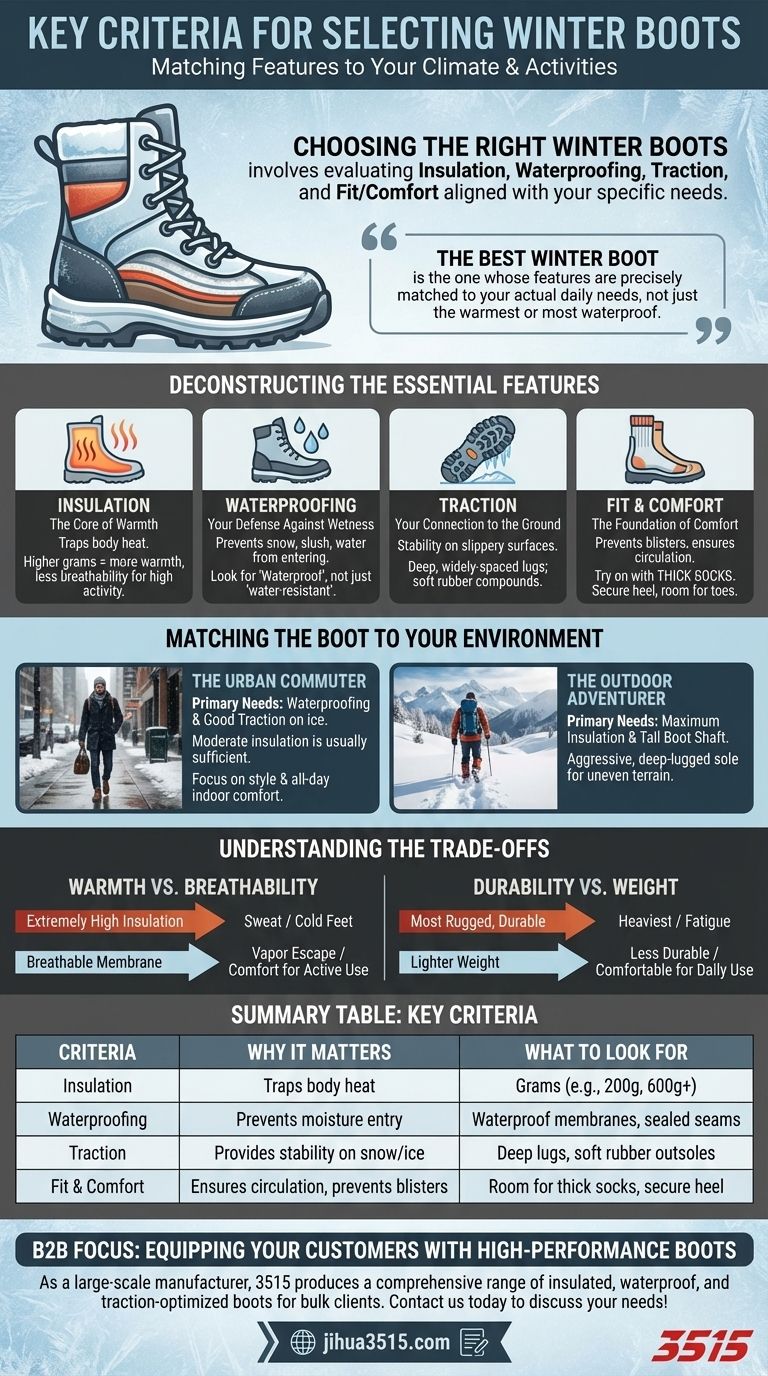Choosing the right winter boots involves evaluating several critical criteria to ensure your feet remain warm, dry, and secure. The key factors are the level of insulation, the effectiveness of the waterproofing, the traction of the sole, and the overall fit and comfort, all of which must be aligned with your specific winter activities and climate.
The best winter boot is not simply the warmest or most waterproof one available. Instead, it is the boot whose specific features—insulation, traction, and materials—are precisely matched to your actual daily needs, from city commuting to deep-snow hiking.

Deconstructing the Essential Features
To make an informed decision, you must first understand the function of each core component of a winter boot. Each feature serves a distinct purpose in protecting you from the elements.
Insulation: The Core of Warmth
Insulation is arguably the most important factor for warmth. It acts as a thermal barrier, trapping your body heat and preventing the cold from penetrating the boot.
Different boots offer varying levels of insulation, often measured in grams. Higher numbers generally mean more warmth but can also lead to less breathability if you're highly active.
Waterproofing: Your Defense Against Wetness
Keeping your feet dry is just as critical as keeping them warm, as moisture rapidly pulls heat away from the body. Effective waterproofing prevents snow, slush, and water from getting in.
Look for materials and construction described as waterproof, not just water-resistant. This often involves a waterproof membrane built into the boot's upper.
The Sole: Your Connection to the Ground
The sole, or outsole, determines your stability on slippery surfaces. Look for deep, widely-spaced lugs made of soft rubber compounds that remain flexible in the cold for maximum traction on snow and ice.
The stiffness of the sole should also match your activity. A more flexible sole is better for walking and casual wear, while specialized activities like winter cycling may require different designs for performance.
Fit and Sizing: The Foundation of Comfort
A poorly fitting boot will be uncomfortable and ineffective, regardless of its other features. A proper fit prevents blisters, ensures good circulation, and maximizes the performance of the insulation.
Always try on boots with the thick socks you plan to wear during the winter. You should have enough room to wiggle your toes, but your heel should not lift excessively when you walk.
Matching the Boot to Your Environment
The ideal combination of features depends entirely on how you plan to use the boots. A boot designed for extreme backcountry use will be overkill and cumbersome for city life.
The Urban Commuter
If your winter consists of walking on cleared or slushy sidewalks, your primary needs are waterproofing and good traction on potentially icy pavement.
Moderate insulation is usually sufficient, and you can place a higher value on style and comfort for all-day wear in an office or indoor setting.
The Outdoor Adventurer
For activities like hiking, snowshoeing, or spending extended time in deep snow, you need maximum protection. Prioritize boots with a high level of insulation.
A taller boot shaft is also crucial to keep snow out, along with an aggressive, deep-lugged sole for grip on uneven, snowy terrain.
Understanding the Trade-offs
Selecting the perfect boot always involves balancing competing priorities. Being aware of these trade-offs is key to avoiding a purchase you'll regret.
Warmth vs. Breathability
Extremely high levels of insulation can cause your feet to sweat during strenuous activity. This moisture can then make your feet feel cold and clammy.
If you are very active, look for boots that pair warmth with a breathable membrane to allow sweat vapor to escape.
Durability vs. Weight
The most rugged, durable boots are often the heaviest. While they offer maximum protection, their weight can cause fatigue during long walks or hikes.
Consider how much walking you will do. A lighter boot may be far more comfortable for daily errands and commuting, even if it is slightly less durable in the long run.
Making the Right Choice for Your Goal
Ultimately, your primary activity dictates the right boot. Use your intended purpose as the final filter for your decision.
- If your primary focus is commuting on treated city sidewalks: Prioritize excellent waterproofing and a versatile, grippy sole over extreme insulation.
- If your primary focus is active recreation in deep snow: You need maximum insulation, a tall and fully waterproof design, and an aggressive sole for traction.
- If your primary focus is all-day casual wear in mixed conditions: Look for a balanced boot with moderate warmth, good breathability, and lightweight comfort.
By aligning a boot's specific features with your personal needs, you empower yourself to make a purchase that delivers true winter comfort and safety.
Summary Table:
| Key Criteria | Why It Matters | What to Look For |
|---|---|---|
| Insulation | Traps body heat to keep feet warm | Grams of insulation (e.g., 200g for moderate, 600g+ for extreme cold) |
| Waterproofing | Prevents moisture from entering the boot | Waterproof membranes (e.g., Gore-Tex), sealed seams |
| Traction | Provides stability on snow and ice | Deep lugs, soft rubber outsoles, flexible design |
| Fit & Comfort | Ensures circulation and prevents blisters | Room for thick socks, secure heel, toe wiggle space |
Ready to equip your customers with high-performance winter boots? As a large-scale manufacturer, 3515 produces a comprehensive range of footwear for distributors, brand owners, and bulk clients. Our production capabilities encompass all types of insulated, waterproof, and traction-optimized boots tailored for urban commuters, outdoor adventurers, and casual wear. Let us help you source durable, comfortable winter footwear that meets your market's demands. Contact us today to discuss your bulk order needs!
Visual Guide

Related Products
- Safety Footwear Wholesale Manufacturer for Custom OEM/ODM Production
- Wholesale Safety Footwear Manufacturer for Bulk & Custom OEM Orders
- Premium Wholesale Waterproof Safety Boots High Performance Protection for Industrial Markets
- Customizable Anti-Smash Safety Boots for Wholesale & Private Label Manufacturing
- High Performance Fire-Retardant Waterproof Safety Boots
People Also Ask
- What are OSHA approved shoes? Understanding the Correct Standards for Workplace Safety
- How do safety shoes contribute to cost savings for companies? A Strategic Investment in Risk and Cost Management
- Do snake bite boots work? Your Ultimate Guide to Effective Snake Bite Protection
- Is safety-toe as good as steel toe? Choose the Right Protection for Your Job
- What cultural and environmental considerations are tied to wearing shoes indoors? Balance Hygiene, Tradition, and Foot Health



















